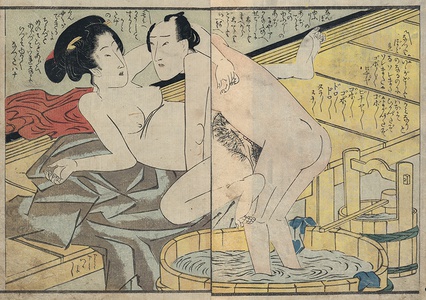| Method | Woodblock (nishiki-e) |
| Artist | Harukawa Goshichi (c.1771-1831) |
| Published | c. 1815 |
| Dimensions | Two Hanshibon sheets [each sheet ~222 x 155 mm] |
| Notes |
Series: Fuzoko wakamizu A scarce print by the Osaka artist Harukawa Goshichi of a man and wife in a bathhouse. Naked figures appear in ukiyo prints but the concept of the nude as a genre in Japanese art did not appear until the introduction of Western painting styles after 1868. Scenes in bathhouses, however, are not uncommon in ukiyo-e, and appear in shunga regularly. There was a long history of mixed public bathing in Japan that was part of the fabric of society until it was outlawed in 1791. While more strictly enforced in Edo and Kyoto it was less enforced in rural areas. It has been noted that segregated bathing lead to more prying and peeping at bathhouses and fetishised seeing the other sex naked, thus heightening the sexual tension, taboo, and eroticism of these bathing prints Shunga is the term used for the body of erotic imagery produced in Japan from 1600 to 1900. The term shunga means spring pictures, a euphemism for sex, and is one of several names for erotic material produced in Japan. Shunga took different formats: painted hand scrolls, painted books, printed books and albums, and sets of prints which were sometimes sold in wrappers. As prints they are one of the genres of ukiyo-e, or Floating World prints, which also include fukeiga (landscape prints), and bijin-ga (prints of beautiful women). Most of the major ukiyo-e artists produced shunga material at some point during their careers, including Utamaro (who produced more erotic books than non-erotic books), Hokusai, and Hiroshige. Produced at the same time as the introduction of full colour woodblock printing, shunga prints and books were made using the most lavish and complicated printing techniques, including gauffrage, metallic inks, mica, complicated printed patterns, and multicolour printing using a high number of different colours. Although prolific in its number and variety, shunga should be seen as more representative of the ideals of the ukiyo, with its emphasis on mutual pleasure, rather than as an accurate representation of Japanese attitudes and practices of sexuality. Shunga present an invitation to pleasure through the bliss of lovemaking and though largely heteronormative, they portray the full gamut of couplings, married or otherwise, often surrounded by lavish settings and objects of pleasure. Harukawa Goshichi (c.1771-1831) was an Osaka ukiyo-e print maker. Ex. Col. Peter Darach Condition: Some rubbing, and soiling lower right and left corners and to small worm holes lower right and left corners not affecting the image. |
| Framing | unmounted |
| Price | £300.00 |
| Stock ID | 53192 |

